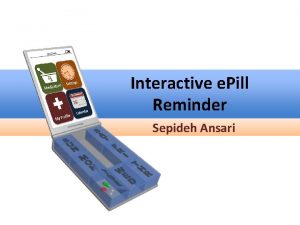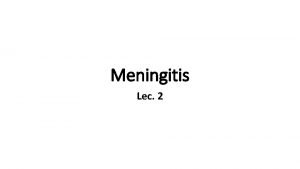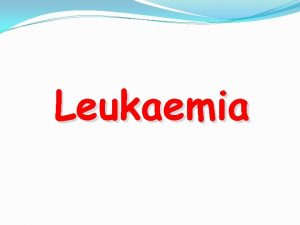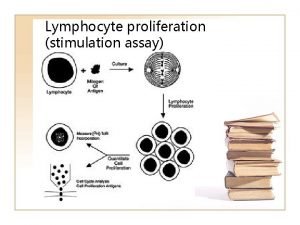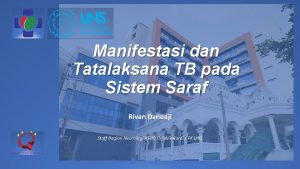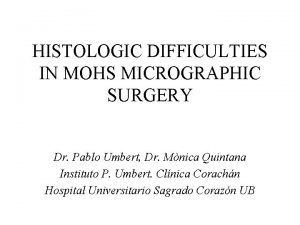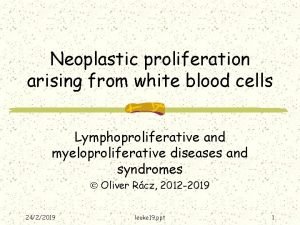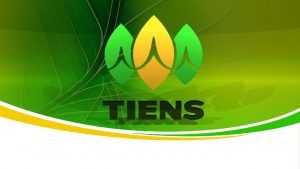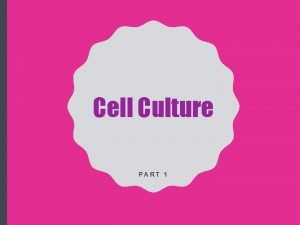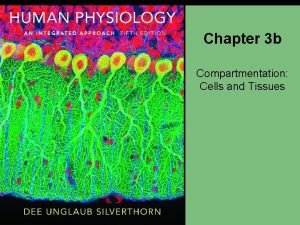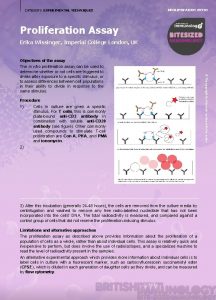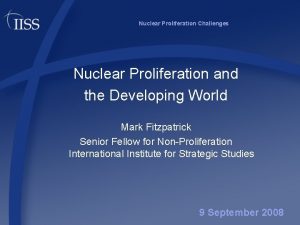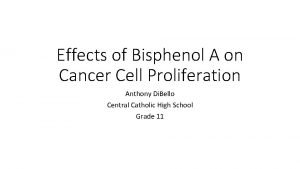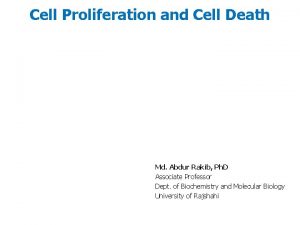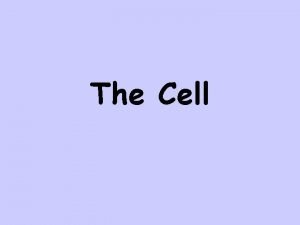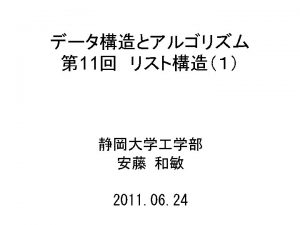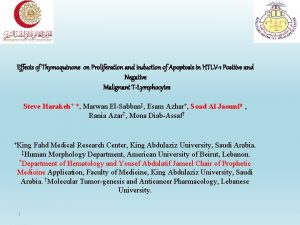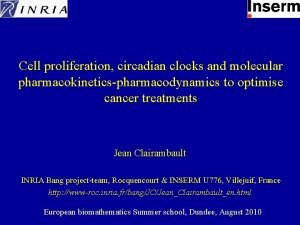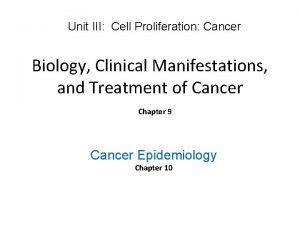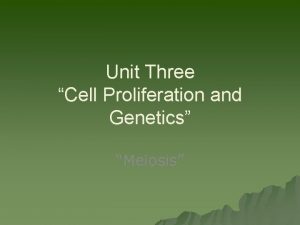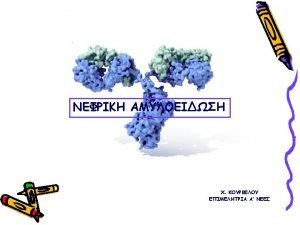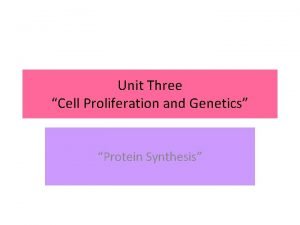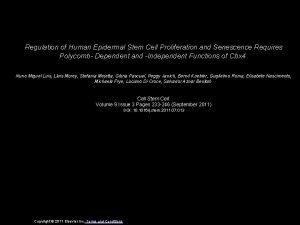ADVIL EFFECTS ON 3 T 3 CELL PROLIFERATION





























- Slides: 29

ADVIL EFFECTS ON 3 T 3 CELL PROLIFERATION, SURVIVORSHIP, AND REGENERATION By Sonali Dadoo School Pine-Richland High School Grade 11 Category Microbiology

WOUND HEALING: “PATHOPHYSIOLOGY OF TISSUE REPAIR AND TRANSFER” BY EDOARDO AUSTONI, VINCENZO GIANNOCCARO Platelets, PMN Photo Credit to: Clini Med http: //www. clinimed. co. uk/ Macrophages, Fibroblasts, Capillaries

WOUND HEALING OVERPRODUCTION OF SCAR TISSUE What is a scar? Body’s natural healing mechanism in response to injury, trauma, etc. Tissue formed during healing process Scar Formation Complications Collagen fibers arranged randomly as opposed to linear, parallel formation Photo Credit: wise. GEEK. com Photo Credit: Schweiger Dermatology

CAUSES OF SCAR FORMATION COMPLICATIONS Myofibroblast Theory Fibroblast differentiation into myofibroblasts Myofibroblasts contract with alpha-smooth muscle actin Contracts edges of wound to repair Lack of apoptosis leads to keloid and hypertrophic scar Fibronectin Theory Fibronectin structure precedes wound contraction Provides structure for fibroblasts

SOME CURRENT TREATMENTS Corticosteroid Injections Reduce collagen synthesis, inflammatory mediators, and fibroblast proliferation 5 -Fluorouracil Pyrimidine analogue with antimetabolite activity Reduces fibroblastic proliferation in tissue culture and postoperative scarring Tamoxifen Nonsteroidal antiestrogen used to treat breast cancer Inhibit proliferation of keloid fibroblasts and their collagen synthesis Manipulation Physically bending joint to break scar tissue Photo credit: Musculoskeletal Network

VARIABLE ADVIL Photo credit: Thisthatbynat Reduces inflammatory hormones in body Generally given to patients in strong doses after surgery to reduce inflammation/trauma and restore joint mobility Average dose 200 mg – 1200 mg

3 T 3 CELLS Mouse derived fibroblastic cell line Standard line used to simulate human fibroblasts Cells proliferate extremely rapidly, but growth stops when cell-to-cell contacts are formed Widely used cell line in research Biologically immortalized cell line Photo credit: National Institute of Health

PURPOSE To examine the effects of Advil on 3 T 3 cell proliferation, survivorship, and regeneration Photo credit: Advil. com

HYPOTHESES Null Hypothesis The addition of Advil (Ibuprofen) will not affect the proliferation, survivorship, and regeneration of 3 T 3 cells Alternate Hypothesis The addition of Advil (Ibuprofen) will significantly reduce the proliferation, survivorship, and regeneration of 3 T 3 cells

MATERIALS bicarbonate + [ 10% Cryotank fetal bovine serum One 75 mm 2 tissue culture treated flasks for complete]) Incubator Six 25 mm 2 tissue culture treated flasks Aspirating Vacuum Line 10% fetal bovine Nikon Inverted serum Compound Optical 3 T 3 Cell Line Scope Trypsin-EDTA Laminar Flow Hood Pen/strep Laminar Flow Hood Macropipette + UV Sterilizing Lamp sterile macropipette Tips (1 m. L, 5 m. L, 10, Labeling Tape m. L, 20 m. L) Sterile PBS Micropipettes + Ethanol (70% and sterile tips 100%) DMEM media (4 m. M Distilled water L-glutamine, 4500 Nikon Inverted mg/L glucose, 1 m. M Microscope sodium pyruvate, and Aspirating Vacuum 1500 mg/L sodium Line Hemocytometer Permanent marker 24 well plate Test tube rack Sterile Filter Lint wipes Advil Capsules Photo credit: New York Microscope Company

PROCEDURE: PREPARING VARIABLE STOCK Photo credit: Advil. net

PROCEDURE: PREPARING THE CELLS A 1 m. L sample of 3 T 3 cells from a Cryotank was used to inoculate 30 m. L of 10% serum DMEM media in a 75 mm 2 culture flask. The media was replaced with 15 m. L of fresh media to remove cryo-freezing fluid and incubated (37° C, 5% CO 2 ) for 2 days until a cell density of approximately 10 6 to 2 x 10 6 cells/m. L was reached. The culture was passed into 6 flasks in preparation for experiment and incubated for 2 days at 37° C, 5% CO 2. Photo credit: Bio. Resource

PROCEDURE: PROLIFERATION Seeded 15 flasks with 3 T 3 cells from the original flasks in 5 m. L of 10% DMEM media each Allowed cells to incubate in CO 2 incubator overnight and adhere to bottom of flask Control group: • 5 flasks Low concentration of variable group: • 5 flasks • Removed 5μL media • Added 5μL variable High concentration of variable group: • 5 flasks • Removed 50μL media • Added 50μL variable Allowed flasks to proliferate in incubator overnight

PROCEDURE: PROLIFERATION (CONTINUED) Next day, trypsinized cells and performed cell counts on the cell suspension § Rinsed with 1 m. L of trypsin, pipetted out § Added 1 m. L trypsin, incubate for 5 minutes § Slap flask and confirm with microscope that cells are no longer adhered to bottom of flask § Quenched reaction with 5 m. L media. Re-added variable. § Re-suspended cells with 1 m. L trypsin wash before taking counts using pipette Loaded hemocytometer with 25 u. L from flask Took 8 counts per flask Counted cells in field of view of hemocytometer under Nikon inverted microscope and multiplied count by 10 3 for total cells/m. L Repeated on Day 3

PROCEDURE: REGENERATION Seeded 15 wells: 1 m. L of 3 T 3 cell suspension in 10% DMEM media Allowed cells to proliferate until reached 80% confluence Made scratch in all plates Well Scratch Kept 5 control wells Took images of plates with Nikon Inverted Microscope Day 1, Day 3 and Day 5 of scratch Compared regeneration over scratch on each well

PROCEDURE: REGENERATION (CONTINUED) Fixed and stained each plate after imaging § Removed media § 1 m. L PBS Wash § 1 m. L Ethanol Wash for 2 minutes § Added 0. 5 m. L of Toluidine Blue Stain § Removed Stain § 1 m. L PBS Wash Compared regeneration over scratch on each well and re-imaged on Day 1, Day 3, and Day 5 Photo credit: Shutterstock. com

PROLIFERATION RESULTS Proliferation Cell Counts (in thousands) 30 25 20 15 Day 1 Day 3 10 5 0 Control Low Concentration of Variable High

PROLIFERATION RESULTS (CONTINUED) Proliferation Cell Counts 30 25 20 15 10 5 0 Day 1 gh Hi w Lo nt ro l Day 3 Co Cell Counts (in thousands) ANOVA Concentration of Variable Day 1 p-value: 2. 16 E -07 Day 3 p-value: 0. 000259

PROLIFERATION RESULTS (CONTINUED) DUNNETT’S TEST Difference of Average of Experimental Group and Average of Control Group T-Value Square Root of two times the MS Value divide by the number of replicates Day 1 Day 3 Concentration T-Value T-Critical Significance Low – 0. 1 X 6. 63 2. 42 Yes High - X 1. 64 2. 42 No Concentration T-Value T-Critical Significance Low – 0. 1 X 2. 12 2. 42 No High - X 2. 54 2. 42 Yes

REGENERATION RESULTS DAY 1 Control Group Low Concentration Group High Concentration Group

REGENERATION RESULTS (CONTINUED) DAY 3 CONTROL GROUP

REGENERATION RESULTS (CONTINUED) DAY 3 LOW CONCENTRATION OF VARIABLE

REGENERATION RESULTS (CONTINUED) DAY 3 HIGH CONCENTRATION OF VARIABLE

REGENERATION RESULTS (CONTINUED) DAY 5 CONTROL GROUP

REGENERATION RESULTS (CONTINUED) DAY 5 LOW CONCENTRATION OF VARIABLE

REGENERATION RESULTS (CONTINUED) DAY 5 HIGH CONCENTRATION OF VARIABLE

CONCLUSION Proliferation Advil significantly reduced 3 T 3 cell growth by Day 3 of the High Concentration and significantly increased proliferation for the Low Concentration on Day 1. The High Concentration on Day 1 and the Low Concentration on Day 3 both appeared to have no significant effect when compared to the control. Regeneration Advil appeared to have little effect on 3 T 3 cell regeneration based on qualitative analysis of images

LIMITATIONS AND EXTENSIONS Limitations Two concentrations of variable used Two days of cell counting Cell counts have small, inherent errors Regeneration analysis was qualitative Extensions Wider range of variable concentrations Earlier exposure to test effects on cell attachment Count cells using time lapse imaging Explore synergistic effects of Advil with other drugs

ACKNOWLEDGMENTS AND REFERENCES Mr. Mark Krotec Pittsburgh Tissue Engineering Initiative Conrad M. Zapanta, Ph. D. Biomedical Engineering Laboratory, Carnegie Mellon University "Hypertrophic Scarring and Keloids. " Medscape. N. p. , 2013. Web. 25 Jan. 2013. <http: //emedicine. medscape. com/>. "Keloids & Hypertrophic Scars. " Derm. Net NZ. N. p. , n. d. Web. 25 Jan. 2013. <http: //www. dermnetnz. org/>. "Keloid Scars. " Schweiger Dermatology. N. p. , n. d. Web. 25 Jan. 2013. <http: //www. nyccosmeticdermatology. com/>. Knapp, Daniels, and Kaplan. "Pathologic Scar Formation. " National Center for Biotechnology Information. U. S. National Library of Medicine, Jan. 1977. Web. 25 Jan. 2013. <http: //www. ncbi. nlm. nih. gov/>. "Scar Tissue Formation. " Breastcancer. org, 17 Sept. 2012. Web. 25 Jan. 2013. http: //www. breastcancer. org/>.
 Sepideh ansari
Sepideh ansari Proliferation of interest groups
Proliferation of interest groups Fibrous proliferation
Fibrous proliferation Arahnoidalna cista
Arahnoidalna cista Uncontrolled clonal proliferation
Uncontrolled clonal proliferation Lymphocyte proliferation
Lymphocyte proliferation Intimal proliferation
Intimal proliferation Industrial proliferation
Industrial proliferation Unusual places to advertise
Unusual places to advertise Folliculocentric basaloid proliferation
Folliculocentric basaloid proliferation Hodgkin's lymphoma
Hodgkin's lymphoma Natural choice europe
Natural choice europe Volvox diagram
Volvox diagram Eukaryotic cell animal cell
Eukaryotic cell animal cell Cell line vs cell strain
Cell line vs cell strain Electrochemical cell vs galvanic cell
Electrochemical cell vs galvanic cell Walker cell and hadley cell
Walker cell and hadley cell Which organelle prepares proteins for specific jobs
Which organelle prepares proteins for specific jobs Difference between bacteria and plant cell
Difference between bacteria and plant cell Vacuole function
Vacuole function What is the gooey liquid in plant and animal cells
What is the gooey liquid in plant and animal cells Phases of cell cycle
Phases of cell cycle Difference between mercury cell and diaphragm cell
Difference between mercury cell and diaphragm cell The scientist mathias schleiden studied _______ in ______.
The scientist mathias schleiden studied _______ in ______. Finite and continuous cell lines
Finite and continuous cell lines Dry cell vs wet cell
Dry cell vs wet cell Prokaryotic vs eukaryotic
Prokaryotic vs eukaryotic Cell-cell junction
Cell-cell junction Cell cycle and cell division
Cell cycle and cell division What is the structure and function of the smooth er?
What is the structure and function of the smooth er?
